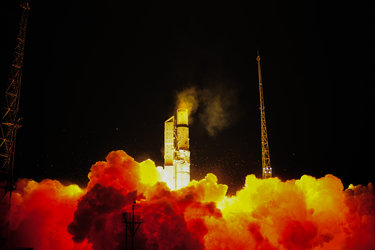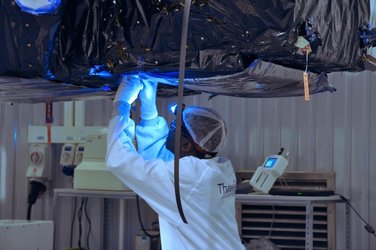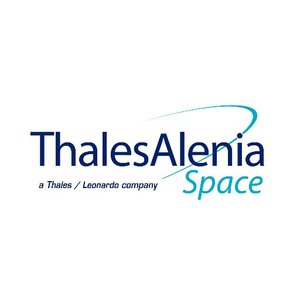Bruno Berruti: Project Manager
Bruno Berruti heads the team that is responsible for delivering the Copernicus Sentinel-3 satellites from the drawing board into orbit. In this interview, Bruno talks about his role as Project Manager, explaining the challenges and rewards he has gained in developing this state-of-the-art mission and getting it ready for launch.

Bruno Berruti, an Italian national, joined ESA’s European Space Research and Technology Centre, ESTEC, in the Netherlands in February 1989. His first position at ESA was Assembly Integration and Verification (AIV) Manager in Columbus, during the early phase of the programme. In 1995 he switched to Earth Observation, joining the MetOp team at the very beginning of the Programme. His position within this project evolved from Thermo-Mechanical Engineer at the beginning to Engineering and AIV Manager and finally Launch Campaign Manager by the end, with the launch of MetOp-A in October 2006. Approximately at the same time Bruno took up his current post of Sentinel-3 Project Manager and has developed the satellite from the hand-over of the mission by the Phase A-B1 team, throughout the entire development phase until the final steps to the launch.
Bruno graduated as a Nuclear Engineer at Politecnico of Turin in 1983. Prior to joining ESA, Bruno worked at Thales Alenia Space Torino (formerly known as Aeritalia) for 6 years as AIV Engineer within the Tethered satellite project, a bilateral cooperation between the Italian Space agency and NASA.
ESA: As Project Manager, what are your very first tasks when assigned with the project?
Bruno Berruti
The ESA Project Manager is given the responsibility to develop a satellite mission within a certain allocated budget and schedule. Project responsibility includes not only the procurement of the satellite but also of the Launch Services, as well as of the flight operations segment (in charge of satellite operations) and of the mission specific elements of the payload data ground segment (in charge of processing the scientific data).
In the early phase of the Project, my first task was to build the ESA team that will take part in the development and implementation of the mission and then to select the Industrial consortium which will be in charge of the satellite development. This second step is usually performed through a competition process and the tasks of my team were first to generate the requirements documentation driving the mission and the satellite design, and later, once the tender offers were received, to select the consortium that better implemented our requirements and satisfied the mission objectives within the imposed financial and time boundaries.
ESA: How big is your team and how did you ensure that it focused together all these years?
Bruno Berruti
The ESA team is made of a “core” group which will follow the programme from start to end and additional people which may contribute to different phases of the programme, depending on the needs. Sentinel-3 Core team includes around 20 people with in addition approximately a similar number of experts supporting the programme part time.
The team had the opportunity to grow together during the execution of the programme. A programme like Sentinel-3 lasts very long, 8-9 years from the moment the programme has started, but the life of a Project knows also many different phases and challenges, moving from the first 3-4 years, mainly spent on paper to document and justify the selected design, to a more “hands on” phase where first the manufacturing and test of all units is followed and later the integrated satellite is tested and prepared for launch. This provides a kind of …”crescendo” in the enthusiasm of the people and in the level of adrenaline in the blood of every team member, increasing the expectation to finally see our Satellite delivered and performing in Orbit.
The continuously evolving activities and growing tension toward the final objective are in my opinion key to ensure the Project team remain focused during such a long time: the final success becomes more and more a team objective, to be achieved and celebrated all together after so many years of hard work!
It should also be added that at Industrial level approximately 100 companies have been involved, leading to more than 1000 people involved worldwide in the execution of the Sentinel-3 programme. Interactions between the teams at different level (ESA, Prime, Subco’s) have been key to insure that feedbacks were provided to all team members and everybody could feel part of the Sentinel-3 family and share the difficulties but also the successes!
ESA: What sets the Sentinel-3 mission apart from other Earth-observing satellites?
Bruno Berruti
Sentinel-3, as the other Sentinels produced in the frame of the Copernicus programme, start a new generation of Earth Observation satellites aiming to support services dealing with climate and environmental changes in an operational fashion. This means no more “one off” experimental mission, but the production of a sustained data flow to be ensured for decades towards a large number of users. The operational aspect of the missions is key to all Sentinels, because require the use of already proven and reliable technologies while still providing a quantum leap in performance compared to the preceding missions.
Specifically for Sentinel-3, this is today within the Copernicus programme the only approved Sentinel which is multi-instrument and therefore multimission. It will provide systematic coverage of all land and ocean areas, providing continuity for a number of existing or previous missions, particularly Envisat. A combination of increased spectral capabilities, wider swath and improved spatial sampling will allow an optical revisit time of less than two days for the entire surface of the Earth. The altimetry mission is designed to cover in full SAR mode all the surface of the earth and implementing an open loop mode allowing precise tracking of rapidly changing zone (e.g. coastal zones), something never done before.
ESA: What have been the main challenges in ensuring that Sentinel-3 will deliver exactly what Copernicus users need?
Bruno Berruti
For the reasons mentioned before (the multi-mission aspects) Sentinel-3 is certainly the most complex among the currently planned Copernicus sentinel missions. Developing a multi-instrument mission which combines both an optical and a microwave payload requires a lot of discussions and iteration between the Project and the different user communities in order to find common solutions satisfying both expectations, e.g. in terms of orbit definition, local acquisition time, satellite configuration, etc… , to ensure expected performances are met. On Sentinel-3 we have been facing requirements associated to the Optical payload requiring specific earth illumination conditions, orbital paths and fields of view which were initially not compatible with the requests coming from the altimetry users. Several iterations were required in order to find final mission parameters which could allow both communities to be satisfied. Further, the users expectations for this mission following the excellent results achieved by its predecessor mission, ENVISAT, were (and still are) very high. Today, with the Satellite AIT behind us and the satellite ready to be launched, I feel confident that Sentinel-3 is ready to deliver the performances the users are waiting for. I think this would be the best reward not only for myself, but also for the more than 100 industrial companies and all the teams at ESA, CNES and EUMETSAT which have been contributing to this development.
ESA: What do you deal with once you ‘pass the ball over’ to the Mission Manager?
Bruno Berruti
My job will not be finished with the launch of the Satellite. After the Launch and until the end of the In Orbit Commissioning, planned to last approximately 5 months, I will still be responsible with my team for demonstrating that the satellite is performing in orbit as expected. This include a first phase dedicated to prove the functionality of the platform itself and a second phase aiming to test and calibrate all the payload to take into account the correct orbital conditions. At the end of this phase, once the readiness of the satellite to start nominal operation will be confirmed, I will then handover the Satellite to the Mission Manager which will manage the mission during the operational phase. During this phase the project team which followed the satellite design will not play any active role in the daily life of the satellite but some expertise will remain available, both at Agency and Industrial level, ready to respond to request for support by the Operational team in case of flight anomalies. This supports falls under what is called Satellite Maintenance Programme, lasting until the end of the satellite life.
ESA: Were there any major lessons learnt or suggestions you have for such large project developments?
Bruno Berruti
I had not yet the time to look back and identify a thorough list of lessons learned. What I can certainly say is that a mission like Sentinel-3, in order to be successful, require extensive interactions among all the entities involved in the definition and implementation of the mission: European Commissions, other involved Agencies (EUMETSAT, CNES), different ESA centers (ESTEC, ESOC, ESRIN) and obviously Industry. Today in the frame of Sentinel-3, but this is true for most of the ESA Programmes, these entities enter in the game at different time, some from the beginning, some when the development has already started from few years, requiring every time some re-discussion of aspects already discussed before and, eventually, even some modification of the way the programme is run. I would consider beneficial to the programme to promote some “coordination” meeting with all parties from the very beginning, which would allow from the start to define common objectives and select an approach to the development and implementation of the mission shared by all parties, with an increased synergy among the work performed by the respective teams.
Editor's note:
This is one in a series of interviews with some of the key people that are involved in the Sentinel-3 mission. Please check back as further interviews will be added in over the coming weeks.








